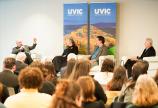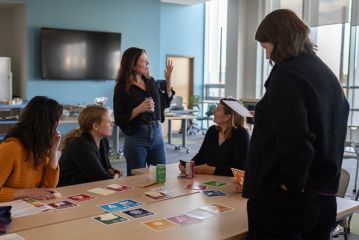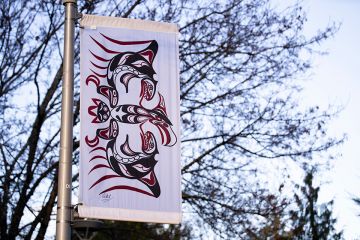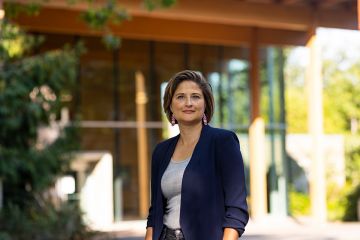Reflections on 10 years of truth and reconciliation
- Lisa Abram

Her Excellency The Right Honourable Mary Simon, Governor General of Canada, shared opening remarks last week at an emotional University of Victoria event to commemorate the 10th anniversary of the Truth and Reconciliation Commission (TRC) Calls to Action. Simon touched on her personal experience at the TRC when she shared stories about her childhood and education in Nunavik, and the children in her community who were sent to residential schools.
Simon remarked that “when the TRC report was released 10 years ago, most Canadians learned about what happened for the first time. And I remember people being horrified, saying ‘I did not know.’ Years later, the findings of unmarked graves of children at former residential school sites moved people even more.”
Under the stalwart leadership of the late former Senator Murray Sinclair, along with the dedicated and often difficult work of the TRC Commissioners, Survivors, and many others, the TRC has left an immeasurable impact on Canadian society. Today, the TRC continues to play a pivotal role in the daily lives of Canadians, shaping the path towards collective understanding of truth, reconciliation and the change called for within Canadian society,
In a recent letter, Simon, who is also a UVic Honorary LLD, tells Canadians that she is “encouraged to see Survivors, Elders and so many people supporting each other as we work to recognize Canada’s true, national history.”
Alongside UVic faculty John Borrows (Law); Andrea Walsh, Smyth Chair in Arts and Engagement (Social Sciences); and Carey Newman, Impact Chair in Indigenous Art Practices (Fine Arts), Associate University Librarian – Reconciliation Ry Moran moderated a panel discussion to remind, encourage and inspire Canadians to think about actions past, present and future.
Simon impressed upon the audience the breadth of innovative work that UVic has done to respond to the 94 Calls to Action— some of them activated in the UVic Indigenous Plan—and spoke about the university’s hub for knowledge with its Indigenous resurgence and language revitalization program, the world’s first JD/JID law degree, the soon-to-be opened National Centre for Indigenous Laws (NCIL) at the Faculty of Law, the recent installation of the Survivors’ Flag, Orange Shirt Day, and decolonizing efforts on campus.

Sharing truth through visual testimonies
During the panel discussion, Walsh, visual anthropologist and honorary witness to the TRC, spoke about the role that repatriating art from residential schools plays in the journey to reconciliation. Through her work with Survivors of the Alberni Residential School she has repatriated personal childhood paintings that once belonged to them.
When Walsh reflects on these significant moments, she sees through the lens of the Survivors what these pieces of paper mean to them—not just as sacred treasures, but as physical connections between generations. “This is the only thing I have as a nine-year-old,” said one Survivor.
For Walsh the artwork is a catalyst for starting difficult family conversations, contributing to governance, and for storytelling. Her hope for the future is that these fragile works of art will guide difficult conversations and action.
The Witness Blanket – the power of community engagement
Multi-disciplinary artist Newman discussed the way that art can participate in truth, the formation of it, and the holding onto it in the process of reconciliation. His view of truth is seen on three levels: a personal one—how it reaches individuals; on a communal level—how it can bring people together, and on a structural level—for how it can impact and affect bigger things in subtle ways.
Watching people interact with his large-scale art installation the Witness Blanket, Newman noticed certain objects resonate when viewing the blanket – where an individual object will connect a person to a memory of their own life and experience. “Once we make a personal connection to something, it becomes important,” explains Newman. “And once it becomes important, then we are willing maybe to participate, to be uncomfortable, to roll up our sleeves, and do some of the work that needs to be done.”
As the concept for Newman’s project started to come to fruition, he found more people contributing to its creation, slowly building trust and developing ideas. “Throughout that process, I was changing my relationship with my material,” says Newman. “Once I started getting contributions from people—and I knew that they were mementos, that they had memories attached to them— it elevated my responsibility to them.”
Indigenous law and legal orders
Law professor Borrows shared his perspective that he appreciates that the calls to action are calls that affect all sectors of society and provided examples of colleagues and former students who are embodying Indigenous law in their respective communities.
Referring to the work of Doug White, a former student and chief in his community, and advisor to the premier, Borrows said that by “constantly bringing forward the importance of our laws in the Law Society's reforms, and in the legislature through the United Nations Declaration on the Rights of Indigenous Peoples, [it highlights] the notion that you live law through people. It is not just an abstraction that's in case books or legislation, but it really is illustrated by their lives.”
Using the example of colleague UVic law professor Val Napoleon as the “heart and soul” for bringing to fruition the NCIL and fulfilling the call for Indigenous law institutes, Borrows says “we are the agents of law. We have the ability and the power to shape law through our participation, as opposed to the unilateral executive orders [handed] down. It's an important moment that indigenous law presents another view of how we practice together.”
A new chapter begins
Towards the end of her opening remarks, Simon provided an overview of the work that has been done in advancing the calls to action. She reflected on the many “firsts “that are happening in this country sparked by an awakening due to the TRC—witnessing the historic apology by the Pope in Canada; meeting with Canada’s Indigenous leaders and King Charles before his coronation to renew relationships with the Crown; the creation of the First Nations University of Canada in Saskatchewan, and the first Inuit University grounded in Inuit culture and language to be opened in a few years time.
Looking back on the last 10 years, Moran believes that our collective response should be clear in looking ahead, and that we need to maintain hope, belief, and conviction that respectful relationships and human rights will endure any obstacles and roadblocks placed in the way.
“Perhaps more than anything, the opportunity at hand is to remember the long and difficult struggle that it took to even make those 94 Calls to Action possible in the first place,” says Moran. “Generations fought, resisted, and struggled to create the opportunity for that Commission to even occur in the first place. This is not something we should take for granted, nor is it something that should be trivialized.”
“Ajuinata, never give up,” Simon implored the audience, using an Inuktitut word, reminding all in attendance that people need to engage students and youth in current discussions as they will be the stewards to carry reconciliation into the future.
Delivering on Truth and Reconciliation Commission Calls to Action
Photos
In this story
Keywords: Indigenous, reconciliation, decolonization, community, government
People: John Borrows, Andrea Walsh, Carey Newman, Ry Moran, Val Napoleon, Kevin Hall






